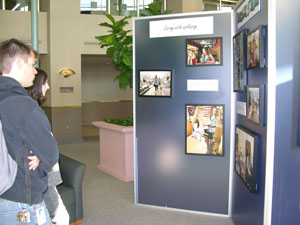 |
Austin Jelcick and Tess Eidem, students from UNMC’s Biomedical Research Training Program (BRTP), take a look at the epilepsy exhibit currently on display in the Durham Outpatient Center West Atrium. The exhibit will be on display through Nov. 12. |
The photography exhibit was developed to educate the public about epilepsy by capturing the daily activities of patients with the condition. The goal of the program is to convey, through compelling photographs and personal testimonials of seven patients, that people do lead full and rewarding lives despite the challenges epilepsy presents.
Of major chronic medical conditions, epilepsy is among the least understood and is often surrounded by a social stigma. The leading non-medical problem confronting people with epilepsy is discrimination in education, employment and social acceptance. The participants in the exhibit were eager to share their lives and experiences in an effort to reduce the stigma and common misconceptions that often surround epilepsy.
Epilepsy, the third most common neurological disorder in the United States, affects about 2.8 million people in the United States. Although anyone can get epilepsy, it is most prevalent among very young and very old. This year approximately 200,000 people in the United States will be diagnosed with epilepsy.
The Nebraska Epilepsy Center at UNMC’s hospital partner, The Nebraska Medical Center, is the most comprehensive center of its kind in the region and has the technology, treatment options and medical expertise to provide any type of therapy in the world.
The center is led by a trained epileptologist, Sanjay Singh, M.D., associate professor in the UNMC Department of Neurological Sciences, and employs a comprehensive four-phase monitoring and treatment program using some of the most advanced diagnostic equipment available. The sophisticated technology enables doctors to accurately pinpoint the site of a seizure and type of epilepsy.
For hundreds of years, epilepsy was a condition that was difficult to treat and that few physicians clearly understood. Today, however, thanks to medical advancements, many people affected by epilepsy are treated successfully and live normal and productive lives. In Nebraska, approximately 20,000 people are affected by epilepsy. About 6,000 of these individuals have intractable epilepsy, the most difficult to treat, and require specialized care.
The Nebraska Epilepsy Center offers several new and promising treatment options that are helping patients with even the most difficult to treat epilepsy cases. Many of these patients do not respond well to medications and may be considered candidates for resective surgery or vagal nerve stimulation. Both procedures offer new hope to patients, who in the past, had no options past medications.
The “Living with epilepsy: freedom to be” exhibit, sponsored by UCB, Inc, a biopharmaceutical company with offices in Smyrna, Ga., has been on display at medical meetings and other epilepsy centers throughout the country.